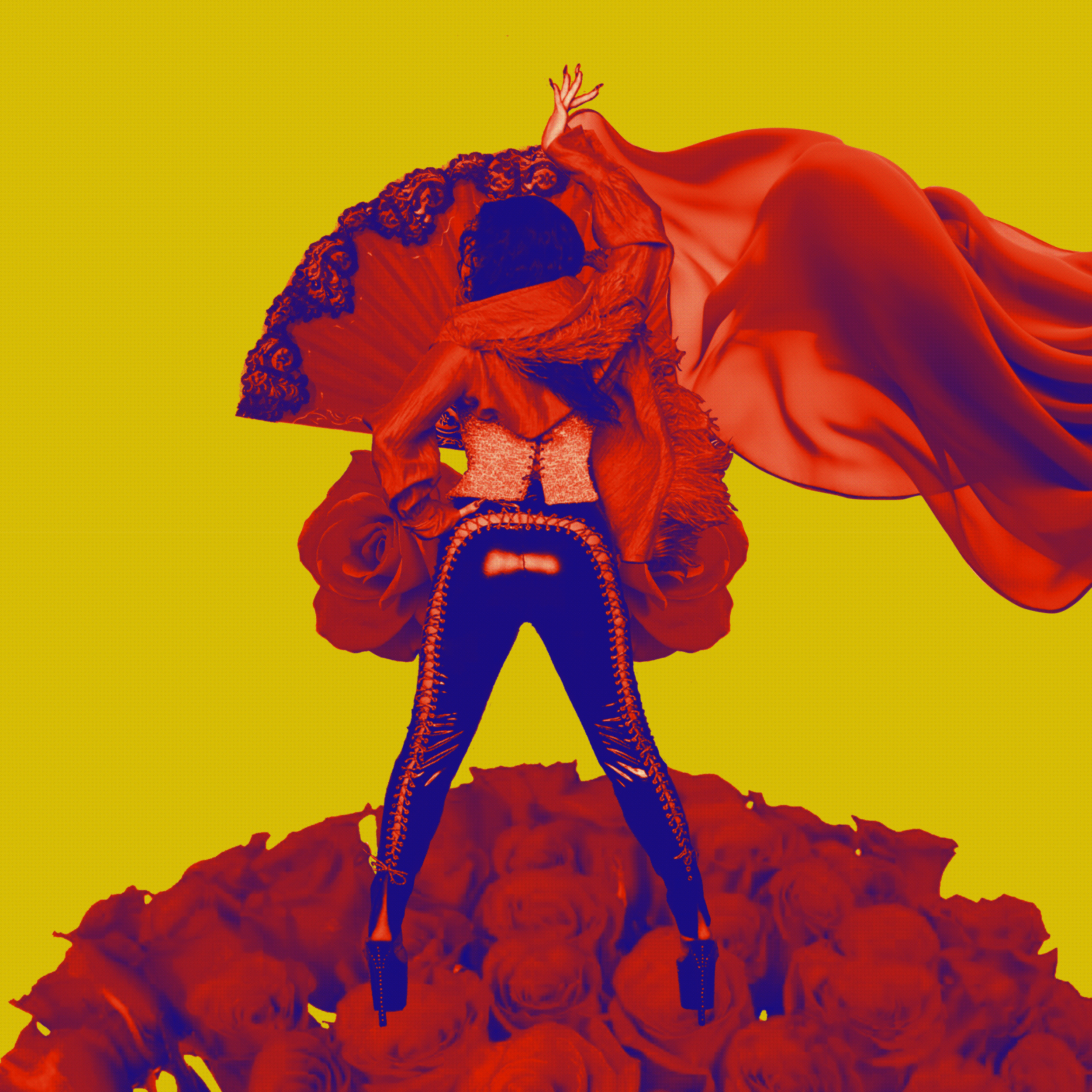Reimagining tradition: Rosalía’s place in the history of flamenco.
Exploring the complex interplay of flamenco traditions in Rosalía’s multifaceted discography.
artwork by Taylor Pate.
In the minds of many, Rosalía is synonymous with images of red fans, ruffled dresses, and floreo wrist motions. Her vocal technique and color, rhythmic clapping, scratchy acoustic guitars, and chants of “ay!” harken back to Spanish flamenco, one of the oldest and most complex musical traditions of Europe. But Rosalía combines this ancient art form with drum machines, synths, audio effects, autotune, and pitch distortion, evoking a sound that is closer to electronic music or hip hop than anything you would hear in a traditional Spanish tablao. With this fusion, Rosalía creates a unique genre blend that is entirely her own. And while her provocative music has amassed millions of listeners, it has also placed her at the center of historical debates surrounding identity, culture, appropriation, and what constitutes flamenco music in the first place.
Flamenco is a complex form of music and dance with origins in Roma, Arab, Jewish, Moorish, Christian, Caribbean, and Latin music. The people of Andalusia, the Southern port state of Spain, blended this broad array of musical influences throughout the fifteenth to nineteenth centuries. Flamenco became an oral tradition amongst Andalusian families and was persecuted, but eventually commercialized, during Francisco Franco’s regime in the mid-1900s.
The flamenco threads woven through Rosalía’s music can be broken into three categories: voice, rhythm, and mode. As a professionally trained flamenco singer, Rosalía somersaults through technically impressive melismas with the same vocal prowess as her flamenco predecessors, yet she also sings with a clear tone that sounds dissimilar from the raspy voices of traditional vocalists. The rhythm and meter used in her music are specific to the flamenco tradition, relying heavily on twelve-beat patterns with emphasis on the third, fourth, ninth, and tenth beats of the phrase. Rosalía’s frequent use of Phrygian mode (a tonal mode with a flattened second note, often called “flamenco mode”) is part of what makes her melodies sound so “flamenco-esque.” However, her instrumentation and structure are where her music deviates sharply from traditional flamenco.
Rosalía’s second studio album, El Mal Querer (2018), is a perfect case study of how Rosalía strikes the musical balance of traditional flamenco flourishes and electronic elements. In “Malamente,” she paints pictures of ancient Spanish culture through lyrical imagery and dialectic abbreviations common to flamenco music (e.g., “salido” becomes “sali’o”). Sonically, her music is anything but ancient; wavy synths set a melodic backdrop for hand claps that sound like they were quantized by a drum machine. “Pienso En Tu Mira” uses the complicated twelve-beat compás and 12/8 meter—a form that is highly uncommon in popular music, which tends to stick to 4/4 meter. Instead of following flamenco tradition and emphasizing beats with firm handclaps, the downbeats of the song sound like a digital drum mixed with a forceful record scratch noise. In “Maldición,” harmonized vocal melismas soar up as Rosalía wishes for love and tumble down as she describes the eternal pain of longing. Halfway through the song, an interlude of digital slice sound effects opens the window to an entirely new sonic world. “Di Mi Nombre” uses a traditional “alí alí” chant at the opening and chorus, but it is autotuned and pitch distorted. While “Que No Salga La Luna” samples a bulería by famous artist La Paquera de Jerez, “Bagdad” samples “Cry Me a River” by Justin Timberlake. On paper, Rosalía’s second album looks like whiplash, but in recording, it sounds like an impossibly seamless blend of wholly opposite genres. El Mal Querer upsets the idea of an intimate, acoustic flamenco performance, replacing this tradition with eleven unique and explosive electronic soundscapes.
Rosalía’s more recent music, including her 2022 album Motomami, has seemingly strayed from her flamenco influences and ventured further into the realm of synth-pop, urban, and trap music. “Saoko,” for example, uses complex hi-hats, melodically simple vocals, and a deep, distorted bass synth. Yet, if you listen carefully, the song is in Phrygian (flamenco) mode. “Candy” brings back Rosalía’s colorful melismas and uses flamenco dialect, but its instrumental arrangement relies on shimmery synths and a reggaeton beat. “Sakura” highlights melisma even further by stripping the instruments away, using only a piano and no percussive elements—two choices that are very atypical of flamenco music—and spatial echoes and audience effects recall aspects of live performance. “Bulerías,” the name of a popular flamenco sub-style, is the only song on the album that is explicitly flamenco. The track uses flamenco rhythms, and most of the words are sung as melismas, though they become highly distorted toward the end of the track. Celebratory male chants and a melodic female chorus fill out the backing vocals and construct the familial setting of traditional flamenco performance. Motomami forces audiences to listen more closely to the sonic layers and vocal undertones of each song to unearth the flamenco influences that lie beneath the surface.
Rosalía’s most recent music has begun to revert more obviously to her flamenco-pop roots. Her 2023 single “LLYLM” has distinctive flamenco clap patterns and plucky guitars that create a breezy sonic atmosphere, but during the bridge, the music falls away to shine a dramatic, dreamlike spotlight on Rosalía’s vocals. If you listen to one song I’ve referenced in this article, it should be “LLYLM.” While it certainly isn’t her most popular track, it singularly showcases Rosalía’s mastery of her style and creates the perfect confluence of flamenco and pop music.
Even with her musical background and popularity within the flamenco sphere, Rosalía has faced fervent backlash from flamenco purists. Defining flamenco is more difficult than simply identifying musical elements because flamenco is more than sounds—it is a culture and an oral and embodied tradition. Some scholars argue that true flamenco can only be created and performed by Andalusians who grew up immersed in the music and dance. Rosalía, by this definition, will always be an outsider even though she does not purport to be an insider, but rather identifies as a student of the style. Regardless of how Rosalía positions herself, her bold incorporation of flamenco elements into her music continues to outrage those who deem themselves insiders and allure those who deem themselves outsiders.
Through the same way of fusion by which flamenco originated, Rosalía’s years of mixing and matching different styles have allowed her to create a sound that is entirely unique to her discography. Whether it is positive or negative, Rosalía’s music is undoubtedly disruptive, provocative, and worth an informed listen.
edited by Joseph Mooney, Editor-in-Chief.
artwork by Taylor Pate.

